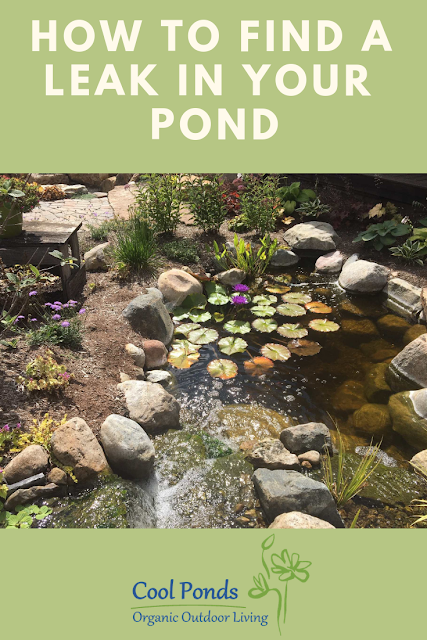Water Feature Repair
We know that when a water feature isn't right, it's a huge headache. When you know you're losing water, but you have no idea where to look or how to fix it, it's very frustrating.
So hopefully if you have the misfortune of suffering a leak, this repair primer will help!
Read on here to find out how to REALLY check the water level in your pond.
A leaking water feature consistently loses the same amount every day. If there's a large variation in water loss, then you're experiencing evaporation, plant expiration, etc. Read more about the causes of water loss here.
Measure your water loss over several days. Make sure you're measuring at the same time of the day, and account for any water you might have to add to the pond. And measure at the same spot in the pond.
If your water loss is inconsistent (1" one day, 3" the next), then it's very likely your water loss is just from evaporation. During a hot summer, our ponds can lose quite a lot of water -- sometimes we have to top our ponds off twice a week!
If you lose water very consistently, you're losing water. Move on to the next step.
So you are leaking! Now what?
You need to pinpoint the source of the water loss. If you have pumps running water-- whether it's a small "spitter" or fountain, a waterfall, a filter-- something running, shut them off. Measure your water level when you turn it off and leave it off for 24 hours. Measure again.
Did you lose water with the pump off?
If yes, then you know that your leak (or at least some of your leakage) is occurring somewhere in the pond itself. You have a couple options at this point. You can let the water drain until it stops-- where it stops is where the leak occurs. A common place is around the skimmer faceplate. If those are old screws, it's possible they have rusted out. We can show you how to replace the screws and re-seal the faceplate.
If the leak is not around your skimmer, then you can try to find either a hole in the liner around where the water dropped to or a low edge. It might be possible to patch the hole. It depends on the age of the liner. Please note that this is a VERY rare occurrence with quality 45mil rubber liner!
Your other option, which might be easier but also a lot more money: to replace the liner completely.
You didn't lose water with the pump off?
Then you know your leak is somewhere between your pump and whatever running water source you have (waterfall / spitter / filter / etc). Turn your pump back on and see if you can find any damp spots or obvious spouts of water. This is not always possible. Very often there is no clear evidence of water leakage.
Go through these spots in this order (ordered by most likely to least likely):
- Check the top of your filterfall / waterfall. Make sure no water is flowing out of the back from misplaced filter pads or water plants. Sometimes the filterfall can settle over winter and tip backwards.
- Check for low edges on the side of your waterfall and creek. You'd be amazed how much water one little low spot in your liner can lose! Pull up the liner and readjust so that all the liner is above the water level.
- Check the connection to your filterfall. Just like the skimmer, these bolts can corrode over time. We can teach you to replace these with stainless steel and new silicone.
- If you haven't found the leak from here, you'll need to run what's called a "test pipe." We can help you set up and run your test pipe.
---------------------------------------------------------
Finding a leak is not easy, but it is not impossible. We will walk you through the process with as much detail as possible. If you have any specific questions, please do not hesitate to come in and chat with us.



Comments